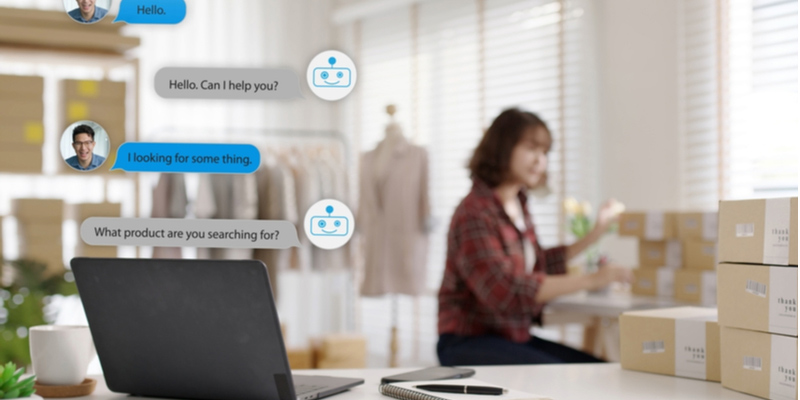There’s a silver lining to the pandemic. Yes, you read that right.
In the midst of all its devastation, COVID-19 actually came bearing one important gift: It has boosted our desire to give gifts. It has given us a new sense of empathy and generosity, experts say, because we’ve deeply missed spending time with our family and friends over these past many months. To bridge the connection gap, make up for the lost time, and express our feelings—and just for no reason at all—we’re giving gifts. The urge to gift is booming!
In this new and expanded atmosphere of giving, brands and their contact centers have unlimited opportunities to make meaningful connections with customers as they search for, select, and purchase gifts more than ever before. In fact, smart contact centers can leverage a variety of strategies to meet goals, exceed customer expectations, provide exceptional CX, and build loyalty and lifetime value among customers.
Why and when we give, as well as what we give, have all been revolutionized. Signs that gift-gifting was growing in volume and scope over the past couple of years began roughly in the early months of the pandemic. According to thinkwithgoogle.com, global searches for “online gift” had already increased by 80% in 2020 as compared to 2019.
Holidays and special occasions still lead the pack in giving gifts, with two of the biggest— Valentine’s Day and Mother’s Day—coming in the months after the huge winter holidays. But gifting was also undergoing a metamorphosis even before the pandemic. No longer confined to holidays and special occasions, gifting is now a year-round proposition. It’s embedded in our psyches: We simply like to gift gifts, pretty much all the time, and more and more frequently, act on those urges. Experts say we’ve learned to love committing “random acts of kindness,” or giving gifts for essentially any (or no) reason at all.
Gifting or shopping—it just feels good
Reasons for deciding to give and selecting a particular gift are varied. But behind those reasons are complex processes in our brains and bodies that drive our decisions. Although we like the feeling of delighting other people with gifts, it’s actually the gift-givers themselves who experience all kinds of positive residual effects. Gifting releases “feel-good” chemicals in the brain, such as serotonin, dopamine, and oxytocin, that create a warm-glow effect, not to mention endorphins, which produce the positive “helper’s high.” No wonder we love to gift! Even when we’re not gifting, we boost our moods when we shop, window shop, and even browse online—all of which release dopamine.
The perfect framework for exceptional CX
While customers generally count on receiving exceptional CX from the brands they trust, happy shoppers, and especially those purchasing gifts, provide fertile ground for contact centers to take CX to a new level by making already-happy customers that much happier. Knowing who customers are and what they want, making personal connections with them, removing CX barriers and friction, and helping agents hone high-value skills like listening and problem-solving can make all the difference in providing the kinds of satisfying and responsive experiences that boost CSAT and build customers for life.

There’s another advantage of gifting, in that it, too, can be a “gift” that keeps on giving to brands and contact centers. Here’s why: Every interaction with a customer who is purchasing a gift provides a two-for-one opportunity to build loyalty—not just with the gift giver who is having a great experience but also with the gift recipient, who is likely to purchase something similar from you at a later time.
Keeping customers coming back for more
Consumers continue to shop—and give gifts—at record levels. Retail e-commerce sales for Q3-2021 alone were nearly $205 billion. And the U.S, Census (census.gov) reports that the number of people purchasing goods and services online in 2021 exceeded 2.14 billion—up from 1.66 global digital buyers in 2016. NICE CXone customers who continued to thrive through the pandemic have, among other things, relied even more heavily on their contact centers to provide frictionless, responsive CX and in the midst of the Great Resignation, they continue to make extraordinary efforts to retain agents and ensure that they have the tools for success.
Gift-giving dynamics are second nature to NICE CXone customers Wine Country Gift Baskets and Teleflora, whose respective products have long been gifting favorites for traditional occasions. But in keeping with gifting trends, Wine Country’s gourmet gift baskets and Teleflora’s amazing floral arrangements are increasingly sought out as gifts throughout the year, including by increasing numbers of repeat customers. “[Our customers] use our gifts to convey a message and a sentiment that they care, and we love being the ones to provide that service for our customers.” Says Houdini Inc,/Wine Country Gift Baskets General Manager Al Niemuth, stressing that the contact center is central to the company’s customer satisfaction and success.
Staying nimble to meet demand
For both Wine Country and Teleflora, providing seamless CX to customers during wild fluctuations in volume and other challenges, both anticipated and unanticipated, is possible due to the scalability, adaptability, and flexibility afforded by the CXone platform. “Fourth quarter—moving into the holiday season—is our biggest time,” says Jeff Fawcett, Wine Country Call Center and Training Manager. “But we also see spikes at Mother’s Day, Father’s Day, Valentine’s Day, Easter, and even Halloween…In November, for example, we scale from 30 to as many as 600-800 agents,” who, Fawcett says, can be CX-ready very quickly with CXone training and user-friendly agent interfaces.
Likewise, with Teleflora’s network of multiple contact centers and hundreds of agents that serve both tens of thousands of florists and handle millions of customer interactions, the company must seriously gear up—without sacrificing CX quality—at various times during the year. During peak holidays—Valentine’s Day and Mother’s Day are two of the industry’s biggest—Teleflora increases staffing by 300% to handle the massive surge in orders. Soon after the company moved to the platform, CXone solutions enabled it to substantially increase its capacity to handle interactions and subsequently build business volume.
Meeting customers where they are
It’s important to know that for a growing share of customers, the journey with a given brand begins well before they land in the contact center. For the gift giver, especially, the journey likely begins on a brand’s website, and that certainly holds true for Wine Country and Teleflora. Browsing is part of the fun! But it’s also why contact centers must be able to meet customers where they are, ensuring that frictionless experiences are delivered seamlessly, not only in the contact center but also beyond it. Extending this “seamlessness” to all potential touchpoints means redefining the customer experience, or CX, more broadly as customer experience interactions, or CXi.

As customers have increasingly transacted digitally, contact centers have responded to their demands by adopting a digital-first omnichannel environment, enabling them to interact when and how they prefer. Customers now expect contact centers to offer chat as a standard communications option, and many, especially among Gen Z and Millennial cohorts, increasingly want to interact on social apps like WhatsApp. AI-powered IVRs and chatbots now give customers streamlined self-service options for routine information, with the assurance that a live agent is immediately available.
The personal connection of contact centers
The personal touch is never out of fashion, according to Wine Country’s Niemuth. “Some of our volumes did shift to the website,” he says.” But the contact center is the place where our customers really want to reach out and have that personal connection with us. It gives us an opportunity every day to deliver on our message and our promise to our customers.”
The value of the personal connection is borne out in studies of how consumers prefer to shop and why. The consulting firm, Deloitte, the publication Chain Store Age, and others have, at different times, found that despite the staggering growth of e-commerce year over year, a remarkable portion of the population still has concerns about shopping online. Doubts about online privacy, as well as concerns over cybercriminals, the practices of Internet companies themselves, and the potential collection of data by the government, have all been cited as issues businesses need to address. Total conversion to online shopping among the population at large appears to be way overstated.
Likewise, for now, at least, we can file the total demise of brick-and-mortar under “myth.” Many consumers still prefer brick-and-mortar, and with COVID-19 appearing to wind down in parts of the country, these customers are anxious to get back in there. Personal interaction instore and being able to interact directly with products are two of the top reasons. Nonetheless, many of us were shopping less in person even before the pandemic due to factors like time, convenience, and product access. We may not be going back into stores in large numbers.
But what if contact centers offer consumers key advantages from both the worlds of brick-and-mortar and e-commerce: Purchasing efficiency served with a personal connection? NICE CXone customer Vera Bradley seems to have found the winning combination in the frictionless experiences it provides its customers. The company is as well-known for its ability to build successful, long-term relationships with its customers across a variety of media as it is for its colorful bags and accessories—long-time favorites among those purchasing for themselves, as well among those buying the perfect any-occasion gift. Not surprisingly, the company’s CSRs are key to its success, because they provide an unparalleled personal connection to the company that Vera Bradley customers want.
Also recognizing its customers’ concerns about data privacy and security and paying online, Vera Bradley utilizes CXone's PCI compliance, which tokenizes customers’ credit card information without the CSR on the line. Vera Bradley customers like this system and express their appreciation almost daily: “Thank you for having a system like this,” says one. “I feel better knowing I don’t have to share my personal information with anyone.”

Vera Bradley’s customers’ journeys most certainly begin on its colorful website or other visual, social platforms like Instagram. But those journeys continue with CSRs, who have the in-depth product knowledge and who are the links to the Vera Bradley culture and expansive community. The role of the company’s CSRs can’t be overstated. This is why the organization was among the first to pilot a work-from-home model to improve engagement and retention. It worked: Productivity and motivation among the CSRs soared.
The Vera Bradley program was developed before the pandemic—and way before the more recent and protracted Great Resignation. Although it has wreaked havoc on workforces everywhere, this mass exodus is especially threatening to contact center staff. And as technology-driven as contact centers are, they are dependent on agents—the providers of one-on-one CX and the personal connection customers will always need, whether shopping or probably, even more, selecting just the right gift. Strategies to retain agents—by improving employee engagement, motivation, and productivity—have risen to the top of contact center managers’ priority lists—and rightly so. They’re boosting agent satisfaction through CXone’s real-time metrics but also AI-assisted tools that can take routine interactions off agents, freeing them up to spend more time helping customers with their high-value problem-solving skills.
Contact centers have limitless opportunities to make meaningful connections and build loyalty by providing exceptional CX to customers as they navigate selecting and purchasing gifts. Providing digital-first omnichannel, being agile and adaptable, and giving agents the right CX tools will all help ensure that contact centers meet—and exceed—customer expectations.
Can the CXone next-gen cloud platform take your contact center to the next level? Find out how CXone helps build customer loyalty and lifetime value with experiences that flow!



